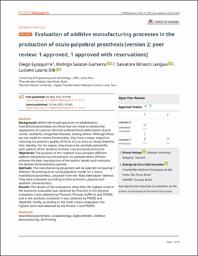Evaluation of additive manufacturing processes in the production of oculo-palpebral prosthesis [version 2; peer review: 1 approved, 1 approved with reservations]

Ver/
Descargar
(application/pdf: 1.115Mb)
(application/pdf: 1.115Mb)
Fecha
2023-02-14Autor(es)
Eyzaguirre, Diego
Salazar-Gamarra, Rodrigo
Binasco Lengua, Salvatore
Lauria Dib, Luciano
Metadatos
Mostrar el registro completo del ítemResumen
“Background: Within the broad spectrum of rehabilitation, maxillofacial prostheses are those that are made to restore the appearance of a person who has suffered facial deformation due to cancer, accidents, congenital diseases, among others. Although these are not made to restore functionality, they have a major impact on restoring the patient's quality of life as it is an area so closely linked to their identity. For his reason, they have to be carefully tailored for each patient, which tends to increase cost and production time
Objectives: The purpose of this research is to compare different additive manufacturing mechanisms, to evaluate which of them achieves the best reproduction of the leather details and maintains the desired dimensional properties.
Methods: The manufacturing equipment will be selected comparing 7 different 3D printing of an oculo-palpebral model for a future maxillofacial prosthesis, obtained from the “Mais Identidade” Method. They were evaluated according to their economic, physical and aesthetic characteristics.
Results: The results of the evaluations show that: the highest score in the economic evaluation was obtained by PhotonS; in the physical evaluation it was obtained by PhotonS, Phrozen Suffle XL and PRO95; and in the aesthetic evaluation it was obtained by PRO95 and Objet500. Finally, according to the multi-criteria evaluation, the highest score was obtained by the Photon S and PRO95.“
Palabras clave
Colecciones
- SCOPUS [380]

